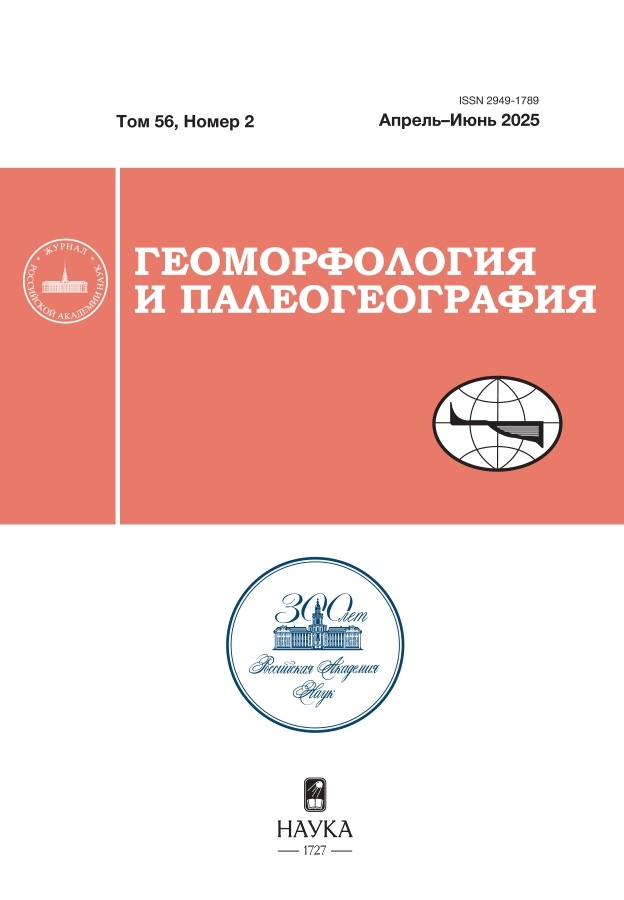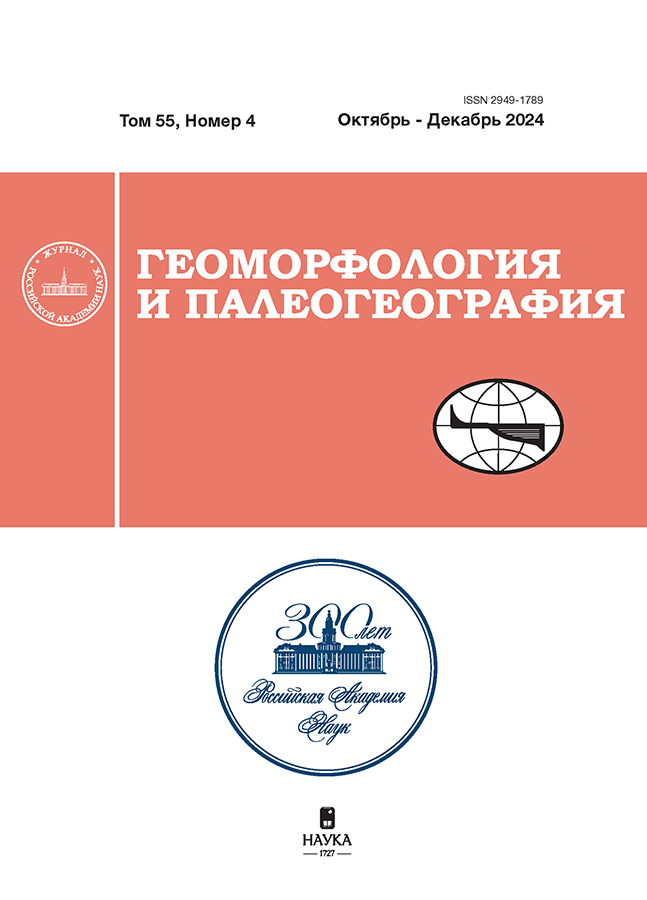Геологические свидетельства суперпаводков в верхнем Приобье
- Авторы: Зольников И.Д.1,2, Филатов Е.А.1, Шпанский А.В.3, Глушкова Н.В.1,2, Данильсон Д.А.1,2, Бордюгова Е.А.1,2
-
Учреждения:
- Институт геологии и минералогии имени В.С. Соболева СО РАН
- Новосибирский государственный университет
- Томский государственный университет
- Выпуск: Том 55, № 4 (2024)
- Страницы: 13-25
- Раздел: КАТАФЛЮВИАЛЬНЫЕ СОБЫТИЯ В ЧЕТВЕРТИЧНОЙ ИСТОРИИ СЕВЕРНОЙ ЕВРАЗИИ
- URL: https://cijournal.ru/2949-1789/article/view/682329
- DOI: https://doi.org/10.31857/S2949178924040023
- EDN: https://elibrary.ru/FHBHBA
- ID: 682329
Цитировать
Полный текст
Аннотация
Статья посвящена критическому анализу и пересмотру представлений о геологическом строении, генезисе и истории формирования отложений, выполняющих долину Верхней Оби от Бийска до устья р. Томи. Постановка проблемы обусловлена тем, что существующие представления об аллювиальной лестнице террас, интегрированные с идеями о перигляциальном аллювии и гигантских ледниково-подпрудных бассейнах на юге Западной Сибири, противоречат накопленному объему фактического материала. Показано, что в Верхнем Приобье широко развиты отложения V и IV террас, сложенных монастырской и бийской катафлювиальными толщами. Каждая из них начинается валунно-галечниками с окатанными глыбами, надстраивается косослоистыми гравийными песками с галькой и завершается параллельно переслаивающимися песками, алевропесками, алевритами. Их суммарная мощность нередко превышает 100 м. Монастырская толща коррелируется с ининской толщей Горного Алтая; ей возраст предварительно определяется как конец среднего неоплейстоцена. Бийская толща коррелируется с сальджарской толщей Горного Алтая; ее возраст предварительно определяется как соответствующий второй ступени верхнего неоплейстоцена. Катафлювиальному прорыву конца последнего ледникового максимума соответствует большереченская толща (III4), параллельно слоистые пески, которые в разрезах Верхнего Приобья достигают 20 м по мощности. Большереченская толща коррелируется с отложениями чибитского гляциокомплекса Горного Алтая. Фациально-генетическими и стратиграфическими аналогами суперпаводковых отложений долины Оби являются отложения, выполняющие древние ложбины стока, которые рассекают Обь-Иртышское междуречье.
Ключевые слова
Полный текст
Открыть статью на сайте журналаОб авторах
И. Д. Зольников
Институт геологии и минералогии имени В.С. Соболева СО РАН; Новосибирский государственный университет
Автор, ответственный за переписку.
Email: zol@igm.nsc.ru
Россия, Новосибирск; Новосибирск
Е. А. Филатов
Институт геологии и минералогии имени В.С. Соболева СО РАН
Email: zol@igm.nsc.ru
Россия, Новосибирск
А. В. Шпанский
Томский государственный университет
Email: zol@igm.nsc.ru
Россия, Томск
Н. В. Глушкова
Институт геологии и минералогии имени В.С. Соболева СО РАН; Новосибирский государственный университет
Email: zol@igm.nsc.ru
Россия, Новосибирск; Новосибирск
Д. А. Данильсон
Институт геологии и минералогии имени В.С. Соболева СО РАН; Новосибирский государственный университет
Email: zol@igm.nsc.ru
Россия, Новосибирск; Новосибирск
Е. А. Бордюгова
Институт геологии и минералогии имени В.С. Соболева СО РАН; Новосибирский государственный университет
Email: zol@igm.nsc.ru
Россия, Новосибирск; Новосибирск
Список литературы
- Адаменко А.М. (1963). Стратиграфия четвертичных отложений Предалтайской равнины в районе слияния рек Бии и Катуни. Труды Комиссии по изучению четвертичного периода. Т. XXII. С. 150–164.
- Адаменко О.М. (1974). Мезозой и кайнозой Степного Алтая. Новосибирск: Наука. 167 с.
- Адаменко О.М., Канопа В.В. (1966). Геологическая карта СССР масштаба 1:200 000. Серия Горно-Алтайская. Лист N-44-XXXII. Объяснительная записка. М.: Недра. 79 с.
- Архипов С.А. (1971). Четвертичный период в Западной Сибири. Новосибирск: Наука. 329 с.
- Архипов С.А., Волков И.А., Волкова В.С. (1980). Палеогеография. В сб.: Палеогеография Западно-Сибирской равнины в максимум позднезырянского оледенения. Новосибирск: Наука. Сибирское отделение. С. 91–99.
- Астахов В.И. (2020). Четвертичная геология суши. СПб.: Изд-во СПбГУ. 440 с.
- Барышников Г.Я. (1992). Развитие рельефа переходных зон горных стран в кайнозое (на примере Горного Алтая). Томск: Изд-во ТГУ. 182 с.
- Бутвиловский В.В. (1993). Палеогеография последнего оледенения и голоцена Алтая: событийно-катастрофическая модель. Томск: Изд-во ТГУ. 252 с.
- Варламов И.П. (1988). Геоморфология. В зап.: Геологическая карта СССР. Масштаб 1:1 000 000 (новая серия). Лист Т-(44), 45. Новосибирск. Объяснительная записка. Л.: Сибгео. С. 114–118.
- Васильев С.К. (2005). Мамонты казанцевского времени юга Западной Сибири. В сб.: Эволюция жизни на Земле. Материалы III Международного симпозиума. Томск: ТМЛ-Пресс. С. 287–289.
- Васильев С.К. (2021). Крупные млекопитающие раннего, среднего и позднего плейстоцена Новосибирского Приобья. Проблемы археологии, этнографии, антропологии Сибири и сопредельных территорий. Т. 27. С. 66–73. https://doi.org/10.17746/2658-6193.2021.27.0066-0073
- Васильев С.К., Орлова Л.А. (2006). К вопросу о возрасте Тарадановского местонахождения фауны крупных млекопитающих. Проблемы археологии, этнографии, антропологии Сибири и сопредельных территорий. Т. 12. № 1. С. 36–42.
- Васильев С.К., Середнёв М.А., Милютин К.И. (2018). Остатки плейстоценовой мегафауны из аллювиальных местонахождений Бибиха, Тараданово на реке Обь (Новосибирская область) и реке Чумыш (Алтайский край). Проблемы археологии, этнографии, антропологии Сибири и сопредельных территорий. Т. 24. С. 47–51. https://doi.org/10.17746/2658-6193.2018.24.047-051
- Зольников И.Д. (2009). Гляциогенно обусловленные суперпаводки неоплейстоцена Горного Алтая и их связь с историей формирования отложений и рельефа Западно-Сибирской равнины. Бюллетень комиссии по изучению четвертичного периода. № 69. С. 59–70.
- Зольников И.Д. (2021). О стратиграфическом значении низких террас сузунской толщи Верхнего Приобья. Геология и минерально-сырьевые ресурсы Сибири. № 10С. С. 7–17. https://doi.org/10.20403/2078-0575-2021-10c-7-17
- Зольников И.Д., Глушкова Н.В., Семенова С.А. (2011). Моделирование катастрофических гляциальных паводков в горах Алтая и на юге Западно-Сибирской равнины. В сб.: Проблемы мониторинга окружающей среды: сборник трудов XI Всероссийской конференции с участием иностранных ученых (24–28 октября 2011 г.). Кемерово: КемГУ. С. 58–62.
- Зольников И.Д., Деев Е.В., Котлер С.А. и др. (2016). Новые результаты OSL-датирования четвертичных отложений долины Верхней Катуни (Горный Алтай) и прилегающей территории. Геология и геофизика. Т. 57. № 6. С. 1184–1197. https://doi.org/10.15372/GiG20160606
- Зольников И.Д., Мистрюков А.А. (2008). Четвертичные отложения и рельеф долин Чуи и Катуни. Новосибирск: Параллель. 180 c.
- Зольников И.Д., Новиков И.C., Деев Е.В. и др. (2023). Последнее оледенение и ледниково-подпрудные озера в юго-восточной части Горного Алтая. Лед и Снег. Т. 63. № 4. С. 171–184. https://doi.org/10.31857/S207667342304018X
- Панычев В.А. (1979). Радиоуглеродная хронология аллювиальных отложений Предалтайской равнины. Новосибирск: Наука. Сибирское отделение. 103 с.
- Парначев С.В. (1999). Геология высоких алтайских террас (Яломанско-Катунская зона). Томск: Изд-во ИПФ ТПУ. 137 с.
- Равский Э.И. (1972). Осадконакопление и климаты Внутренней Азии в антропогене. М.: Наука. 334 с.
- Рудой А.Н. (2005). Гигантская рябь течения (история исследований, диагностика, палеогеографическое значение). Томск: Изд-во ТГПУ. 224 с.
- Шпанский А.В. (2018). Четвертичные крупные млекопитающие Западно-Сибирской равнины: условия обитания и стратиграфическое значение. Автореф. дис. … докт. геол.-мин. наук. Томск: ТомГУ. 24 с.
- Shpansky A.V., Kuzmin Y.V. (2021). Chronology of the MIS 3 megafauna in southeastern West Siberia and the possibility of late survival of the Khozarian steppe mammoth (Mammuthus trogontherii chosaricus). Radiocarbon. V. 63. № 2. P. 575–584.https://doi.org/10.1017/RDC.2021.6
Дополнительные файлы














